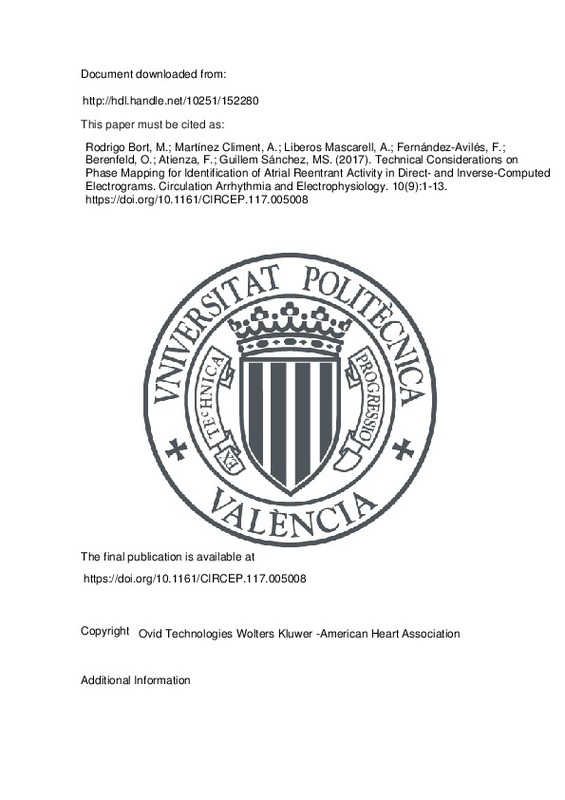Allessie, M., & de Groot, N. (2014). CrossTalk opposing view: Rotors have not been demonstrated to be the drivers of atrial fibrillation. The Journal of Physiology, 592(15), 3167-3170. doi:10.1113/jphysiol.2014.271809
Narayan, S. M., & Zaman, J. A. B. (2016). Mechanistically based mapping of human cardiac fibrillation. The Journal of Physiology, 594(9), 2399-2415. doi:10.1113/jp270513
Guillem, M. S., Climent, A. M., Rodrigo, M., Fernández-Avilés, F., Atienza, F., & Berenfeld, O. (2016). Presence and stability of rotors in atrial fibrillation: evidence and therapeutic implications. Cardiovascular Research, 109(4), 480-492. doi:10.1093/cvr/cvw011
[+]
Allessie, M., & de Groot, N. (2014). CrossTalk opposing view: Rotors have not been demonstrated to be the drivers of atrial fibrillation. The Journal of Physiology, 592(15), 3167-3170. doi:10.1113/jphysiol.2014.271809
Narayan, S. M., & Zaman, J. A. B. (2016). Mechanistically based mapping of human cardiac fibrillation. The Journal of Physiology, 594(9), 2399-2415. doi:10.1113/jp270513
Guillem, M. S., Climent, A. M., Rodrigo, M., Fernández-Avilés, F., Atienza, F., & Berenfeld, O. (2016). Presence and stability of rotors in atrial fibrillation: evidence and therapeutic implications. Cardiovascular Research, 109(4), 480-492. doi:10.1093/cvr/cvw011
Narayan, S. M., Krummen, D. E., Clopton, P., Shivkumar, K., & Miller, J. M. (2013). Direct or Coincidental Elimination of Stable Rotors or Focal Sources May Explain Successful Atrial Fibrillation Ablation. Journal of the American College of Cardiology, 62(2), 138-147. doi:10.1016/j.jacc.2013.03.021
Berenfeld, O., Ennis, S., Hwang, E., Hooven, B., Grzeda, K., Mironov, S., … Jalife, J. (2011). Time- and frequency-domain analyses of atrial fibrillation activation rate: The optical mapping reference. Heart Rhythm, 8(11), 1758-1765. doi:10.1016/j.hrthm.2011.05.007
Gray, R. A., Pertsov, A. M., & Jalife, J. (1998). Spatial and temporal organization during cardiac fibrillation. Nature, 392(6671), 75-78. doi:10.1038/32164
Rodrigo, M., Guillem, M. S., Climent, A. M., Pedrón-Torrecilla, J., Liberos, A., Millet, J., … Berenfeld, O. (2014). Body surface localization of left and right atrial high-frequency rotors in atrial fibrillation patients: A clinical-computational study. Heart Rhythm, 11(9), 1584-1591. doi:10.1016/j.hrthm.2014.05.013
Vijayakumar, R., Vasireddi, S. K., Cuculich, P. S., Faddis, M. N., & Rudy, Y. (2016). Methodology Considerations in Phase Mapping of Human Cardiac Arrhythmias. Circulation: Arrhythmia and Electrophysiology, 9(11). doi:10.1161/circep.116.004409
Guillem, M. S., Climent, A. M., Millet, J., Arenal, Á., Fernández-Avilés, F., Jalife, J., … Berenfeld, O. (2013). Noninvasive Localization of Maximal Frequency Sites of Atrial Fibrillation by Body Surface Potential Mapping. Circulation: Arrhythmia and Electrophysiology, 6(2), 294-301. doi:10.1161/circep.112.000167
Haissaguerre, M., Hocini, M., Denis, A., Shah, A. J., Komatsu, Y., Yamashita, S., … Dubois, R. (2014). Driver Domains in Persistent Atrial Fibrillation. Circulation, 130(7), 530-538. doi:10.1161/circulationaha.113.005421
Dössel, O., Krueger, M. W., Weber, F. M., Wilhelms, M., & Seemann, G. (2012). Computational modeling of the human atrial anatomy and electrophysiology. Medical & Biological Engineering & Computing, 50(8), 773-799. doi:10.1007/s11517-012-0924-6
Koivumäki, J. T., Seemann, G., Maleckar, M. M., & Tavi, P. (2014). In Silico Screening of the Key Cellular Remodeling Targets in Chronic Atrial Fibrillation. PLoS Computational Biology, 10(5), e1003620. doi:10.1371/journal.pcbi.1003620
Garcia-Molla, V. M., Liberos, A., Vidal, A., Guillem, M. S., Millet, J., Gonzalez, A., … Climent, A. M. (2014). Adaptive step ODE algorithms for the 3D simulation of electric heart activity with graphics processing units. Computers in Biology and Medicine, 44, 15-26. doi:10.1016/j.compbiomed.2013.10.023
Rodrigo, M., Climent, A. M., Liberos, A., Calvo, D., Fernández-Avilés, F., Berenfeld, O., … Guillem, M. S. (2016). Identification of Dominant Excitation Patterns and Sources of Atrial Fibrillation by Causality Analysis. Annals of Biomedical Engineering, 44(8), 2364-2376. doi:10.1007/s10439-015-1534-x
PEDRÓN-TORRECILLA, J., RODRIGO, M., CLIMENT, A. M., LIBEROS, A., PÉREZ-DAVID, E., BERMEJO, J., … GUILLEM, M. S. (2016). Noninvasive Estimation of Epicardial Dominant High-Frequency Regions During Atrial Fibrillation. Journal of Cardiovascular Electrophysiology, 27(4), 435-442. doi:10.1111/jce.12931
Zlochiver, S., Yamazaki, M., Kalifa, J., & Berenfeld, O. (2008). Rotor meandering contributes to irregularity in electrograms during atrial fibrillation. Heart Rhythm, 5(6), 846-854. doi:10.1016/j.hrthm.2008.03.010
ALHUSSEINI, M., VIDMAR, D., MECKLER, G. L., KOWALEWSKI, C. A., SHENASA, F., WANG, P. J., … RAPPEL, W.-J. (2017). Two Independent Mapping Techniques Identify Rotational Activity Patterns at Sites of Local Termination During Persistent Atrial Fibrillation. Journal of Cardiovascular Electrophysiology, 28(6), 615-622. doi:10.1111/jce.13177
[-]







![[Cerrado]](/themes/UPV/images/candado.png)


